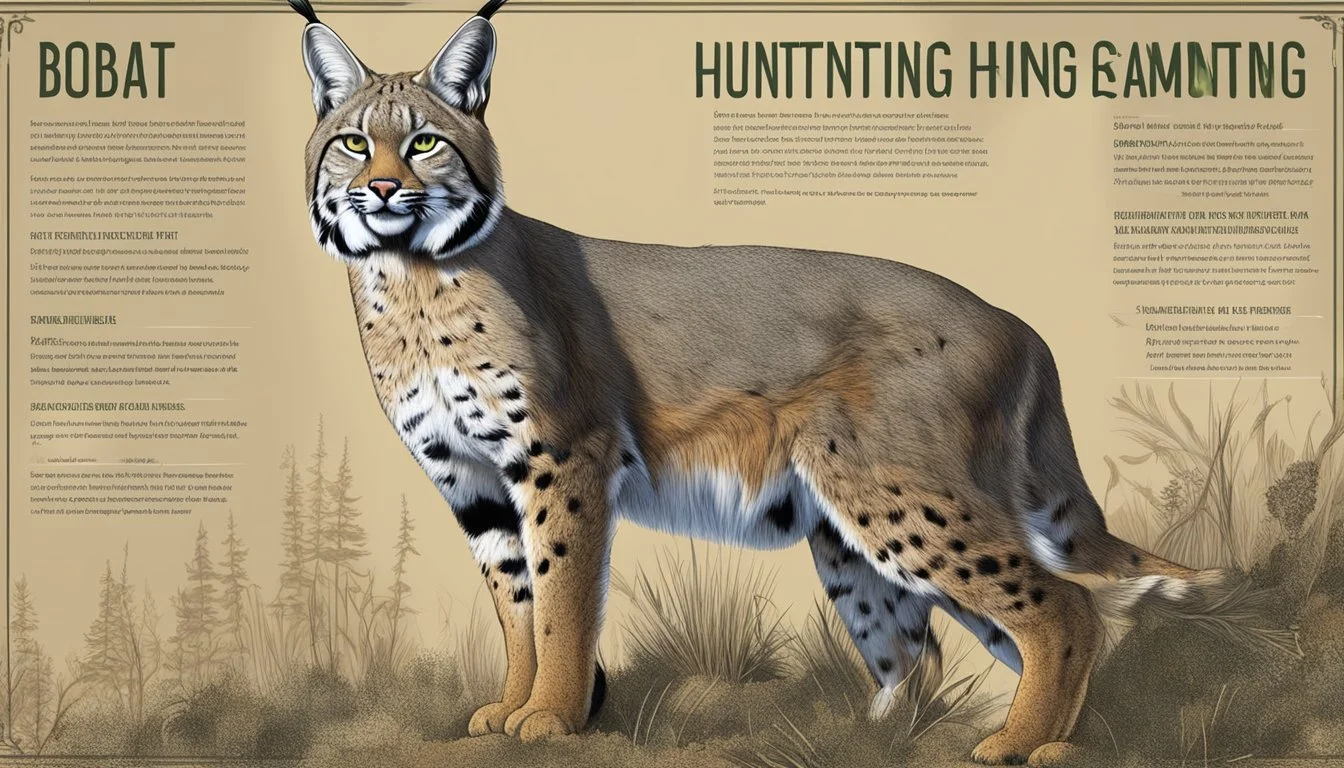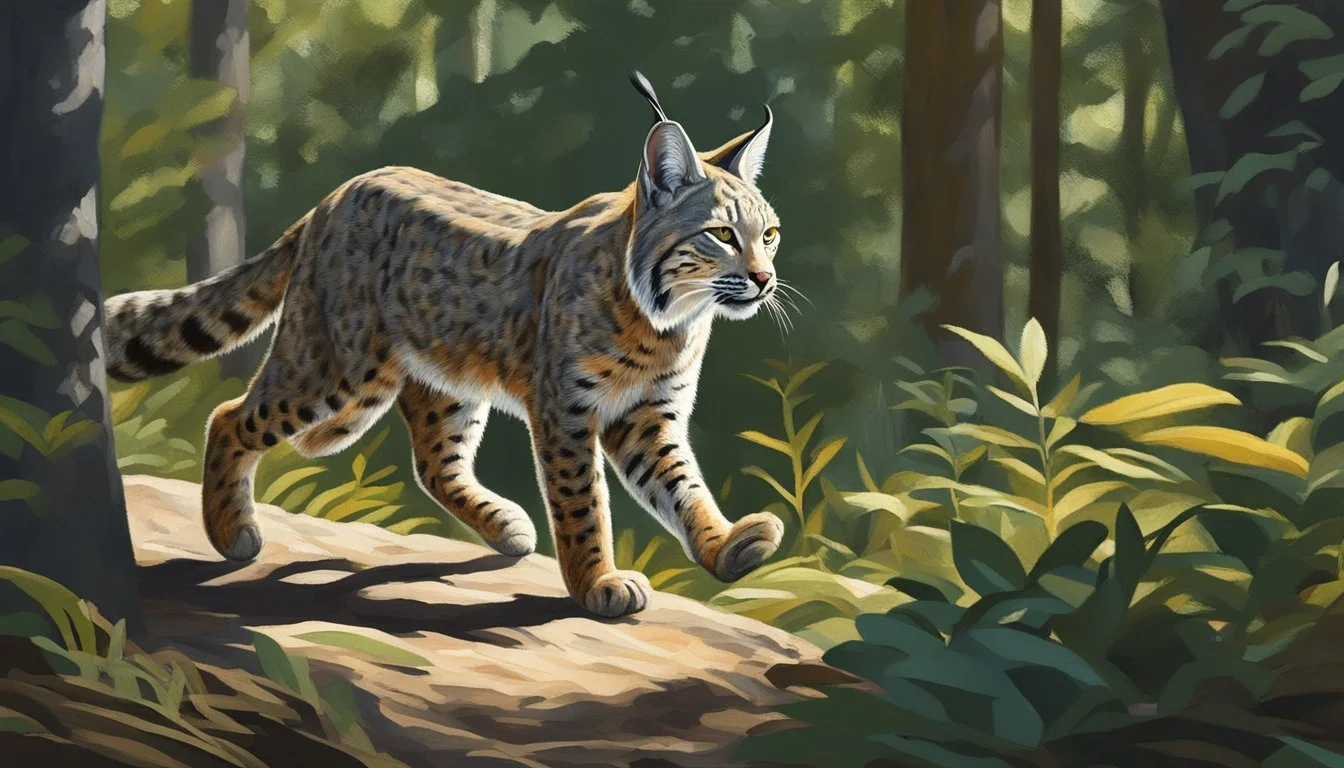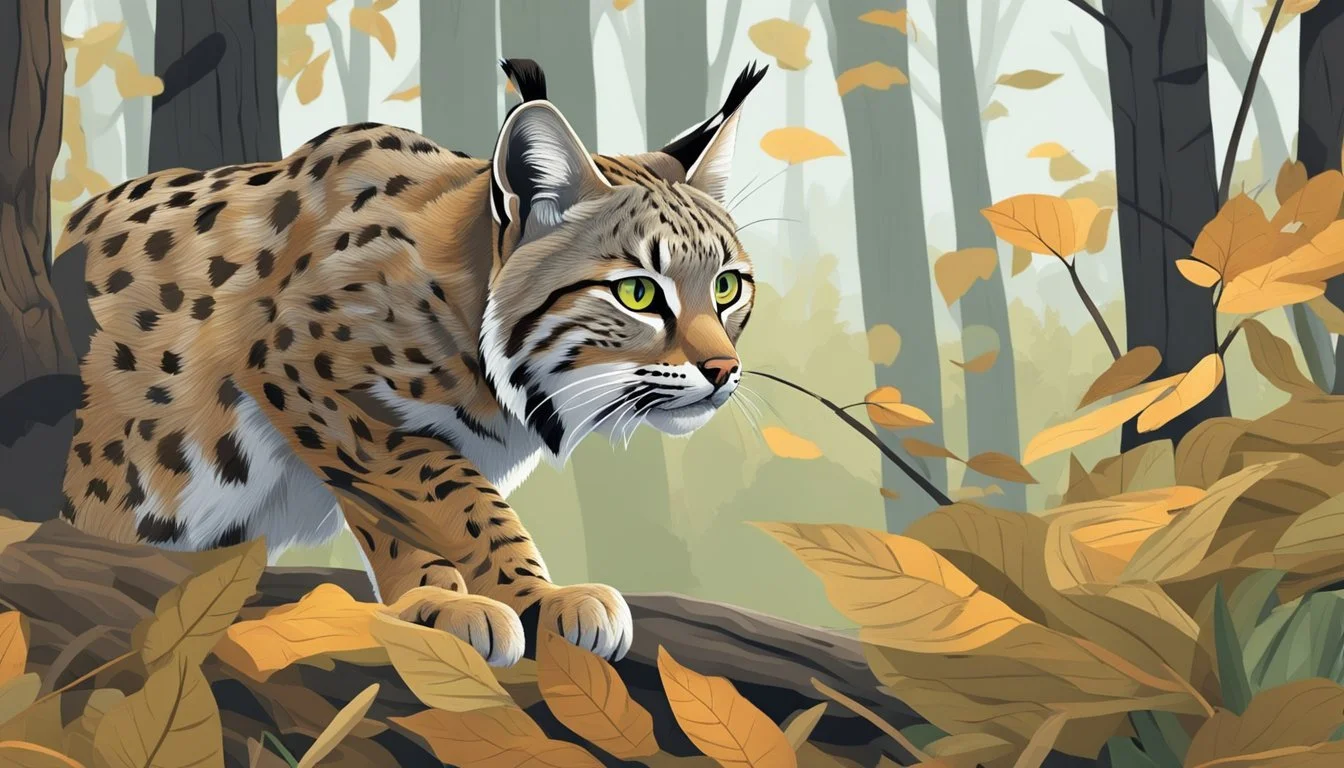Bobcat Hunting Seasons
Regulations and Optimal Times
This Article is Part of Our Guide on Hunting Seasons for Over 70 Common Game Species
Bobcat hunting is a regulated activity in various states across the United States, with precise seasons and rules established to manage the population sustainably and maintain ecological balance. The regulations for hunting these feline predators vary by state, often reflecting the specific environmental and wildlife management needs of the region. In Missouri, for instance, the bobcat hunting and trapping season is open from November 15, 2023, to February 29, 2024, signaling a period when hunters and trappers can legally pursue these animals under the guidance of the Missouri Department of Conservation.
Before engaging in bobcat hunting, hunters must be aware of the necessary permits and the requirement for harvested bobcats to be registered or tagged. This ensures that wildlife officials can monitor bobcat populations and collect valuable data for conservation efforts. Some states may also require hunters to obtain additional tags or permits for certain areas, especially when hunting in designated expansion zones.
While some states propose expansions or restrictions based on scientific data and public consultations, hunters and conservationists must stay informed about the latest regulations, legal hunting methods, and equipment authorized for use. The state-specific regulations serve as a framework to ensure that bobcat hunting is carried out ethically and in a manner that does not threaten their survival, reflecting a push towards responsible wildlife management and conservation practices.
Understanding Bobcat Habitats
The effective hunting of bobcats involves a deep understanding of their habitats, which vary greatly across North America and are influenced by the bobcat population dynamics.
Regional Habitats and Ranges
Bobcats are adaptable predators that are distributed across North America. They thrive in a variety of environmental conditions, encompassing:
Forests: Both deciduous and coniferous forests
Mountains: Elevation offers diverse prey and shelter
Deserts: Arid regions with adequate cover
Swamps: Wetlands provide ample hiding spots
Bobcats establish territories with distinct boundaries, which can range from a few square miles to expansive areas depending on regional prey availability and population density.
Bobcat Population Dynamics
Bobcat populations are determined not just by the abundance of prey, but also by the availability of suitable habitats. Populations tend to be denser in regions with lush forests and abundant resources. Key factors affecting these populations include:
Prey Density: Areas with higher prey densities support larger bobcat populations.
Habitat Fragmentation: The division of continuous habitats can limit population growth and range.
Understanding these dynamics is crucial for setting appropriate hunting seasons and conservation efforts, ensuring the sustainability of bobcat populations across their North American range.
Bobcat Hunting Regulations
Bobcat hunting regulations vary by state and involve specific licensing requirements, designated seasons, approved hunting methods, and set bag limits to ensure the species' sustainability.
Licensing and Permits
In the United States, hunters typically need a hunting license and may require a separate bobcat tag or permit. For instance, in Missouri, a Conservation Permit is mandatory, while in Michigan, a Resident Fur Harvester license is needed. Landowners may have additional privileges but should still comply with state licensing requirements.
Seasonal Framework
Bobcat hunting seasons are established by state wildlife agencies and can range from early November to the end of February. For example, Wisconsin sets its bobcat season from October 15 to December 25 in the first period and December 26 to January 31 in the second period. Meanwhile, Michigan specifies separate dates for various units, such as January 1 to March 1 for Unit A.
Legal Hunting Methods
The legal methods for hunting bobcats include firearm and archery, as well as trapping in some jurisdictions. States may have restrictions on the caliber or type of firearm used. Archery equipment typically includes both compound bows and crossbows.
Hunting Quotas and Bag Limits
Bag limits for bobcats are strictly enforced. In Missouri, bobcat pelts must be tagged, but possession of tagged bobcats by the taker is allowed year-round. Michigan imposes a limit of 2 bobcats per resident fur harvester; additional provisions apply for hunting on private land. Wisconsin sets a daily bag limit of one.
Preparing for the Hunt
Before embarking on a bobcat hunt, it is essential for hunters to prepare the right equipment, understand scouting and tracking techniques, and be aware of safety and ethical considerations. This preparation is critical for a successful and responsible hunt.
Hunting Equipment
Choosing the correct hunting equipment is a fundamental step in preparing for the hunt. Hunters should consider the following:
Firearms: High-caliber rifles and shotguns are commonly used for bobcat hunting. The choice between them depends on the hunter's preference and local regulations.
Archery: Bows or crossbows offer a silent option and require hunters to be closer to the bobcat, increasing the challenge.
It is important to ensure all equipment is in good working condition before the hunt.
Scouting and Tracking Techniques
Scouting and understanding bobcat behavior are key to successful tracking. Techniques include:
Identifying signs of bobcat presence such as tracks, scat, and scratch marks on trees.
Gaining knowledge of the terrain and bobcat territories through maps and possibly consulting with local landowners.
Utilizing these techniques improves the odds of locating a bobcat and ultimately leads to a more efficient hunt.
Safety and Ethical Considerations
Safety must always be the top priority during the hunt, and ethical practices should guide the hunter's actions. This encompasses:
Safety: Wear appropriate safety gear, be aware of one’s surroundings, and handle firearms or archery equipment with care.
Ethical: Hunters should respect wildlife regulations, obtain all necessary permits, and seek permission from landowners when hunting on private property.
By keeping these considerations in mind, hunters ensure the protection of both themselves and the integrity of the sport.
The Hunting Experience
Bobcat hunting requires a blend of patience, skill, and knowledge. Hunters must employ effective strategies, oftentimes with the assistance of trained dogs, and be prepared for the nuances of field dressing and safely transporting their harvest.
Strategies for Success
For hunters seeking bobcats, stealth and awareness are paramount. They typically:
Scout: Identifying signs such as tracks and scat enables hunters to find active areas.
Camouflage: Staying undetected is crucial; hunters wear camouflage to blend into the environment.
Calls: Using predators calls to emulate prey or bobcat sounds can lure them into range.
Patience: Many experienced hunters emphasize the value of waiting silently for the right moment.
Utilizing Hunting Dogs
Hunting dogs can be a vital asset in tracking bobcats. Key points regarding their use include:
Training: Dogs must be well-trained to track the scent of a bobcat without becoming distracted.
Safety: Hunters ensure the safety of their dogs with GPS collars and by knowing the terrain.
Legalities: It is important to check state regulations regarding the use of dogs for hunting bobcats.
Field Dressing and Transporting Harvest
Once a bobcat is harvested, proper field dressing is critical for preserving the fur and meat. Steps usually involve:
Immediate Dressing: Hunters begin field dressing as soon as the bobcat is harvested to prevent spoilage.
Cooling: The carcass must be kept cool during transport to inhibit bacteria growth.
Care with Fur: Handling the fur with care to avoid damage is important for those who value this aspect of the harvest.
Conservation and Management
Conservation and management of bobcats involve regulated hunting seasons, monitoring of their populations, and habitat protection efforts to ensure sustainable coexistence with human activities.
Wildlife Management Practices
Wildlife management authorities implement specific practices to maintain balanced bobcat populations. They establish hunting and trapping seasons based on scientific data concerning population dynamics and ecological impact. Practices such as seasonal restrictions help prevent overharvesting during sensitive times such as breeding or when juveniles are dependent on their mothers. Additionally, the use of check-in and tagging systems for harvested animals allows for close monitoring and helps in gathering data about age, health, and population distribution.
Season Dates: Typically set within a time frame that avoids breeding periods and ensures young bobcats can reach independence.
Harvest Limits: Clearly defined bag limits are essential for preventing excessive take.
Equipment Regulations: Restrictions on types of traps or firearms ensure ethical hunting practices.
Bobcat Conservation Efforts
Bobcat conservation efforts primarily focus on preserving habitat and managing human-bobcat interactions. Conservationists advocate for the protection of natural areas where bobcats can hunt and establish territory without coming into frequent conflict with human developments. Programs may include:
Land Conservation: Safeguarding areas that are crucial for bobcat foraging and denning.
Public Education: Informing communities about coexisting with bobcats and reducing negative encounters.
Research: Ongoing studies into bobcat health, genetics, and migration patterns inform conservation policies.
Legal Protections: Laws such as the Bobcat Protection Act in some regions prohibit hunting and trapping, reflecting the animal's conservation status and the need for its protection.
By integrating responsible hunting regulations and habitat conservation efforts, wildlife management aims to maintain bobcat populations that are healthy and sustainable.
Beyond Bobcat Hunting
Bobcat hunting seasons garner substantial attention, but opportunities to hunt other furbearers and activities hunters can engage in during the off-season also play significant roles in wildlife management and sport.
Other Furbearer Opportunities
Many states provide licensed hunters with chances to pursue a variety of furbearing animals. Some of the most common targets include coyotes, raccoons, and foxes. These animals, much like bobcats, are often hunted for their fur and to manage their populations. Regulations for hunting these species vary from state to state, with specific seasons and bag limits established to ensure sustainable harvests. For example:
Coyote: Often hunted year-round, as they are typically classified as a non-protected species.
Raccoon and Fox: Seasons may run concurrently with or separate from bobcat seasons, usually with specific nightly hunting hours.
Additionally, some regions might have opportunities for hunting more elusive furbearers like the lynx, where legal and in accordance with conservation guidelines.
Hunting in the Off-Season
During the off-season, when furbearer hunting is not permitted, hunters can still engage in several activities to keep their skills sharp and contribute to conservation efforts. This time can be used to:
Scout for future hunts by tracking game trails and signs.
Engage in small game hunting, as species like squirrels and rabbits typically have longer seasons.
Participate in wildlife habitat conservation projects to improve ecosystems for future game populations.
The off-season also provides ample opportunity for hunters to prepare their equipment for the coming season, whether it’s maintaining firearms, organizing gear, or refining their calling techniques.
Additional Resources and References
This section guides the reader to authoritative resources for further study and understanding of bobcat hunting regulations, educational content, and local community engagement.
Educational Materials
One can find comprehensive information about bobcat species, their behavior, and hunting techniques through the New York State Department of Environmental Conservation (NYDEC) and the Missouri Department of Conservation. These organizations provide detailed guides on hunting seasons and conservation efforts. Access to such materials is crucial for both novice and experienced hunters seeking to expand their knowledge on bobcat hunting.
Legal Documentation
The legal framework governing bobcat hunting varies by state and one should consult the specific State Department of Natural Resources or equivalent for precise regulations. Documents typically accessible include season dates, licensing requirements, and harvesting reports. For example, in Missouri, regulations for the 2023-2024 season state that bobcat pelts must be registered or tagged.
Local Hunting Communities
Local hunting communities are valuable resources for sharing experiences, best practices, and recent updates on regulations. Hunters can engage with these communities through local hunting forums, state-specific Facebook groups, or by attending meetings of wildlife and conservation clubs. The Michigan Department of Natural Resources has proposed changes reflecting community input, demonstrating the importance and influence of local involvement.
Frequently Asked Questions
What are the general regulations for bobcat hunting?
Bobcat hunting regulations vary by state, but typically they involve obtaining a proper hunting license and following specific seasons, bag limits, and equipment guidelines.
How can one find out if bobcat hunting is allowed in a particular state?
Most states provide this information through their wildlife department's website. States where bobcat hunting is prohibited will be marked as such in state resources.
What equipment is typically allowed for bobcat hunting?
Legal equipment often includes firearms and archery; however, some states may have restrictions on the type of weapons and ammunition that can be used.
Is there a bag limit for bobcat hunting?
Yes, many states implement bag limits to ensure a sustainable bobcat population. These limits can be found in state-specific hunting regulations.
What is required to legally harvest a bobcat?
Hunters usually need a valid hunting license. Additionally, some states may require a special permit for bobcat hunting. Upon harvesting, reporting the take within a given timeframe may be mandatory.
When is the bobcat hunting season?
Bobcat hunting seasons typically fall between fall and winter, varying by state. Detailed season dates are listed on state wildlife department websites.
Where can one report a harvested bobcat?
Harvests can often be reported online through a state’s designated reporting system or by a hotline provided by the state's game commission.
Glossary of Terms
Bobcat: A medium-sized wildcat native to North America, known scientifically as Lynx rufus. They are a game species with varying hunting seasons across states.
Hunting Season: Designated times of the year when hunters may legally pursue or harvest wildlife. For bobcats, these seasons usually occur between November and February and can vary by state.
Firearm: A device designed to discharge a projectile through the deflagration of a propellant. Firearms are typically used in hunting, subject to regulations including caliber restrictions and hunting method rules.
Trapping: A method of capturing wildlife with devices like snares, cages, or foothold traps. Trapping regulations for bobcats often include tag requirements and checking intervals.
Conservation: Efforts and practices implemented to manage and protect natural resources, including wildlife populations. Hunting seasons and regulations are tools used to maintain sustainable bobcat populations.
Wildlife Management: The practice of maintaining certain wildlife species and their habitats, which includes the enforcement of seasons, bag limits, and hunting methods.
Term Definition Bag Limit The maximum number of animals a hunter is legally allowed to harvest in a given period. Tagging A legal requirement to attach a state-issued tag to harvested game, sometimes used for population tracking. Harvest The act of successfully capturing or killing wildlife during a hunting season.
Note: This glossary includes only terms relevant to the topic of bobcat hunting seasons, and is intended for informational purposes. Regulations can change and may differ by state or region.
Conclusion
Bobcat hunting is regulated at the state level, and regulations can vary widely. Before participating in a bobcat hunt, individuals must familiarize themselves with their specific state's regulations, including season dates and legal methods of take. Hunters need to obtain the appropriate licensing and understand tagging requirements to stay in compliance and contribute to the responsible management of bobcat populations.
Effective hunting techniques are crucial due to the bobcat's elusive nature. Hunters should equip themselves with knowledge about bobcat behaviors, such as their solitary hunting patterns and preferred habitats. The use of electronic calls, scent lures, and understanding the importance of stealth can increase the chance of a successful hunt.
Each state may have its own set of rules regarding equipment, such as types of firearms, archery equipment, or traps that can be legally used. Maps and resources provided by state wildlife agencies can be invaluable for planning and executing a legal and ethical hunt.
In states where bobcat hunting is permissible, it is seen as both a traditional outdoor activity and a means of managing wildlife populations. Hunters are encouraged to see their role as part of a broader conservation effort. They can engage in bobcat hunting as a way to connect with nature and challenge their outdoor skills, while also participating in the stewardship of natural resources.
It is imperative for hunters to stay informed about legislative changes, as wildlife management is an evolving field influenced by ecological research, public input, and conservation objectives. Being well-informed and compliant ensures that bobcat hunting remains a sustainable activity that aligns with wildlife conservation principles.









